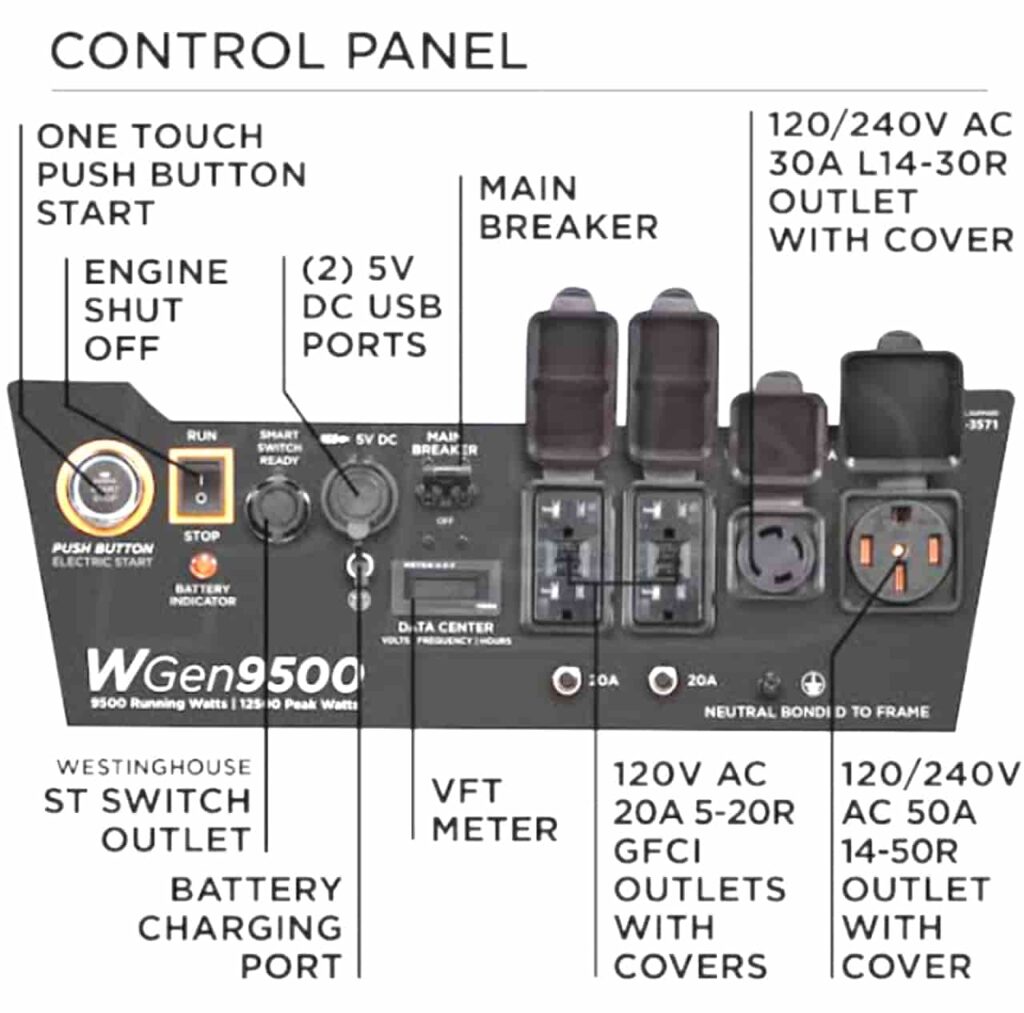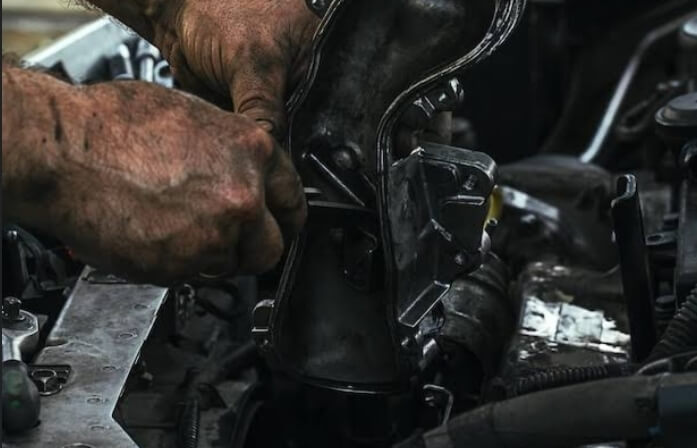As an Amazon Associate, we earn from qualifying purchases. This does not affect the price you pay or the quality of the products you buy. For more information, please read the full affiliate disclosure here.
Generator outlet receptacles come in various types, sizes, and amps; hence, choosing the right one can be a daunting task without knowing about them.
Generator outlet receptacles are one of the most important components when it comes to safely and efficiently connecting electrical devices to generators.
In that sense, whether you’re using a portable generator for camping or as a backup power source during emergencies, having the right receptacles ensures that you can power your appliances and equipment without any compatibility issues or safety risks.
Henceforward, Generator Hacks comes up with this article to explore the different types of generator outlet receptacles available, understanding the key concepts of amps, volts, and watts of these outlets.
We also go further in discussing their safety considerations, guide you in choosing the right receptacles, provide installation instructions, offer maintenance tips, and present best practices for their usage.
Types of Generator Outlet Receptacles
Different generator models have various types of outlet receptacles that can’t be interchanged with one another. Among these receptacles are:
1. Duplex Outlets
The first type of outlet receptacle you should know about is the duplex outlet. Duplex outlets are the standard household outlets you find in most buildings, especially in the United States of America. They are typically rated at 15 or 20 amps and provide 120-volt power. Duplex outlets are suitable for powering smaller appliances and devices such as lamps, chargers, and small power tools.
2. Twist-lock Outlets
The second item on our list is the twist-lock outlet. The twist-lock outlets feature a twist-lock mechanism that ensures a secure connection. They come in various configurations, including 15-amp, 20-amp, 30-amp, and 50-amp ratings. Twist-lock outlets are commonly used for larger power tools, machinery, and certain types of RVs.
3. RV outlets
Thirdly, we have the RV outlets. These outlets are designed specifically for recreational vehicles and nothing else. They provide a convenient way to power RV appliances and systems. The RV outlets are usually 30-amp or 50-amp outlets and offer both 120-volt and 240-volt power.
4. USB Outlets
With the increasing prevalence of USB-powered devices, some generator outlet receptacles now include USB ports. These outlets allow you to directly charge your smartphones, tablets, and other USB devices without the need for adapters or additional chargers.
Understanding Amps, Volts, and Watts

To effectively use generator outlets, it’s important you first understand the concepts of amps, volts, and watts in a concise and relatable manner. Let’s break it down in simple terms.
Amps measure the current flow of electricity. This refers to the movement of electric charges through a conductor, such as a wire. Amperes indicate the rate at which electric charges flow. In practical terms, a higher amperage signifies a greater flow of current, while a lower amperage indicates a lesser flow. You can think of it as the amount of water flowing through a pipe. More amps mean a stronger flow, while fewer amps indicate a weaker flow.
Volts measure the electrical potential, or voltage. Voltage represents the force or pressure that propels electric charges through a circuit. It determines the amount of potential energy available to move the charges. It must be noted that different devices and appliances require specific voltage levels to operate optimally and safely. It’s like the pressure in the water pipe. Higher voltage means more force pushing the electricity, while lower voltage means less force.
Watts quantify the power consumed or produced. Power refers to the rate at which energy is transferred or converted. It indicates how much work can be accomplished within a given period. In electrical systems, watts are used to measure the amount of electrical energy consumed or generated by a device or circuit.
To avoid problems with these receptacles, you must match the ratings of the receptacles (outlets) with the generator. Receptacle ratings tell you the maximum amps and volts they can handle. If you exceed these limits, you risk overloading the system, which can damage equipment or even cause accidents.
To stay safe, make sure the generator’s output matches the requirements of the devices you want to use. Check the voltage, amperage, and wattage needed by your appliances, and choose a generator with compatible outlets and enough capacity to handle the total power demands.
Safety Considerations
When dealing with electricity, safety should always be a priority. Here are some important safety considerations for generator outlet receptacles:
- Grounding requirements: Proper grounding helps prevent electrical shocks and ensures the safe dissipation of electrical faults. Always ensure that the receptacles are grounded according to local electrical codes.
- GFCI protection: Ground Fault Circuit Interrupter (GFCI) protection is also essential for outlets located in damp or outdoor environments. GFCI outlets are designed to trip and cut off power in the event of a ground fault, preventing electrical accidents.
- Proper installation and maintenance: It’s important to install generator outlet receptacles correctly, following the manufacturer’s instructions and any applicable electrical codes. Regular maintenance, including checking for loose connections, frayed wires, or damaged receptacles, is also essential for safe operation.
How to Choose the Right Generator Outlet Receptacles
Selecting the appropriate generator outlet receptacles depends on several factors:
- Identifying power needs: Determine the appliances and equipment you intend to power with your generator. Calculate their combined wattage requirements to determine the appropriate receptacle types and ratings.
- Compatibility with generator type: Different generator types, such as inverter generators or conventional generators, may have specific receptacle configurations. Ensure that the receptacles you choose are compatible with your generator’s outputs.
- Future-proofing considerations: Consider potential future power needs. If you anticipate adding more appliances or equipment, it’s wise to choose receptacles with higher ratings or additional outlets to accommodate increased power demands.
How to Install Generator Outlet Receptacles
The installation process for generator outlet receptacles may vary depending on your specific circumstances and local electrical codes.
However, here is a general, step-by-step guide:
1. Determine receptacle locations.
Decide where you want to install the receptacles, considering accessibility and proximity to the devices you intend to power.
2. Shut off the power.
Before starting any electrical work, turn off the power supply to the area where you’ll be working.
3. Install junction boxes.
Install junction boxes in the chosen locations. Ensure they are securely fastened and properly grounded.
4. Run electrical wiring.
Run the appropriate electrical wiring from the generator to the junction boxes. Follow the recommended wire sizes and types to handle the expected loads.
5. Wire the receptacles.
Connect the wiring to the receptacles, following the manufacturer’s instructions. Double-check all connections for accuracy and tightness.
6. Test and verify.
After installation, test the receptacles with a voltage tester to verify proper wiring and functionality. If everything checks out, restore power and test the receptacles with the intended devices.
Note: Always consult a licensed electrician or professional if you’re uncertain about any aspect of the installation process.
Maintenance and Troubleshooting Your Generator Outlet Receptacles
Regular maintenance helps ensure the longevity and safety of your generator outlet receptacles. Here are some maintenance tips and troubleshooting techniques:
- Regularly inspect receptacles: Check for signs of wear, loose connections, or damage. Tighten any loose screws and replace any damaged or worn-out receptacles promptly.
- Keep receptacles clean. Dust and debris can accumulate over time, affecting the electrical connections. Regularly clean the receptacles using a soft brush or compressed air to maintain optimal performance.
- Troubleshooting common issues: If you encounter issues such as intermittent power, sparks, or overheating, start by checking the receptacles for loose connections or damage. Ensure that your devices are not causing the problem by testing them with other receptacles.
Note: If you’re unable to identify or resolve the issue, it’s advisable to seek assistance from a qualified electrician.
Best Practices for Using Generator Outlet Receptacles
To maximize the effectiveness and safety of your generator outlet receptacles, consider the following best practices:
- Load management: Understand the wattage capacity of your generator and distribute the load accordingly. Avoid overloading the generator by exceeding its maximum wattage output. The Generac smart management module helps greatly in this aspect.
- Extension cords and adapters: Use high-quality extension cords and adapters specifically designed for outdoor or generator use. Ensure they are rated for the wattage requirements of the devices you’re connecting.
- Avoiding overloads and electrical hazards: Be mindful of the power demands of individual appliances and devices. Avoid connecting high-wattage devices to lower-rated receptacles, as it can lead to overloads and potential electrical hazards.
- Follow manufacturer guidelines: Always follow the manufacturer’s recommendations regarding generator usage, receptacle limitations, and maintenance procedures. Adhering to these guidelines will help ensure optimal performance and longevity.
- Safety precautions: Never touch generator outlet receptacles with wet hands, and avoid operating generators in enclosed spaces to prevent carbon monoxide poisoning. Additionally, keep the generator and its outlets away from flammable materials.
Final Thoughts
Generator outlet receptacles play an important role in safely connecting electrical devices to generators. Understanding the different types of receptacles, matching their ratings with generator outputs, and following safety guidelines are essential for a successful and secure power connection.
By choosing the right receptacles, correctly installing them, and practicing proper maintenance and usage, you can ensure the reliable and efficient operation of your generator-powered appliances and equipment.
Additionally, always remember to prioritize safety and consult professionals when needed to make the most of your generator outlet receptacles.
Frequently Asked Questions
1. Can I use a regular household outlet for my generator?
Using a regular household outlet for your generator is not recommended. Most household outlets are not designed to handle the high wattage output of a generator, which can result in overloads and potential fire hazards.
2. What is the difference between 120V and 240V outlets?
120V outlets provide power at a standard residential voltage level, while 240V outlets offer higher voltage levels typically used for larger appliances and machinery.
3. Can I plug sensitive electronics into generator outlet receptacles?
Sensitive electronics, such as computers or televisions, require stable and clean power to operate without issues. To protect these devices, it’s recommended to use surge protectors or voltage regulators specifically designed for sensitive electronics when connecting them to generator outlet receptacles.
4. Are generator outlet receptacles weatherproof?
Some generator outlet receptacles are designed to be weatherproof or suitable for outdoor use. However, not all receptacles have this feature.
5. Can I install generator outlet receptacles myself?
While it is possible to install generator outlet receptacles yourself, it’s crucial to have a good understanding of electrical systems and local electrical codes. If you’re uncertain or lack experience, it’s recommended to hire a licensed electrician to ensure proper installation and compliance with safety regulations.
Share

